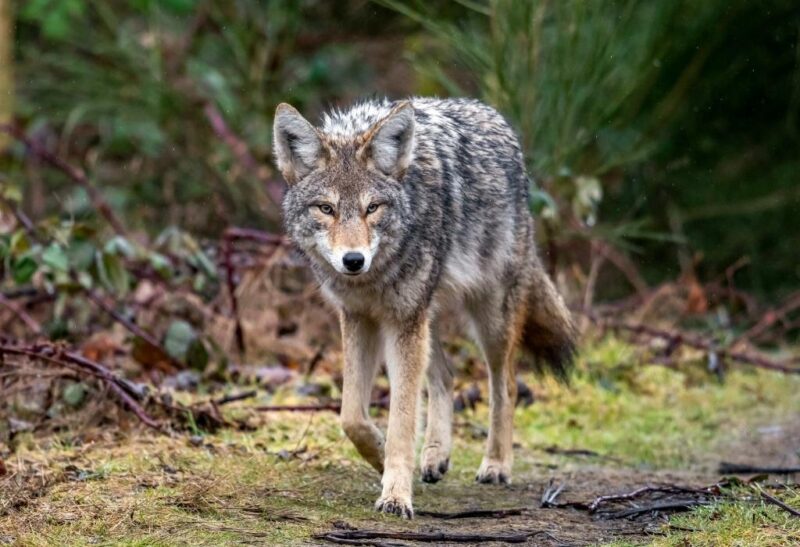Coyotes appear in both rural and urban areas, and this is a common sight to see in fall. These animals’ backgrounds and histories are not pleasing to humans.
It’s best to be aware and wary of their presence as they’re not friendly even though they rarely attack humans. Just like other animals, you can tell if coyotes are nearby through the scat they leave on the ground.
What does coyote poop look like? The poop of the coyote can be dark, black, or the color of the fruits that it ingested. If it’s dark or black, the animal has eaten insects or meat. Some hair and insect parts can be found in its poop. A coyote’s poop is tapered with ends like long tails.
Coyotes are crepuscular, which means that they’re active during dusk and dawn to look for food. The diet of coyotes is diverse, which is from fruits and vegetation to insects and small mammals. Continue reading if you want to be good at distinguishing coyote poop.
Table of Contents
What Does Coyote Poop Look Like?
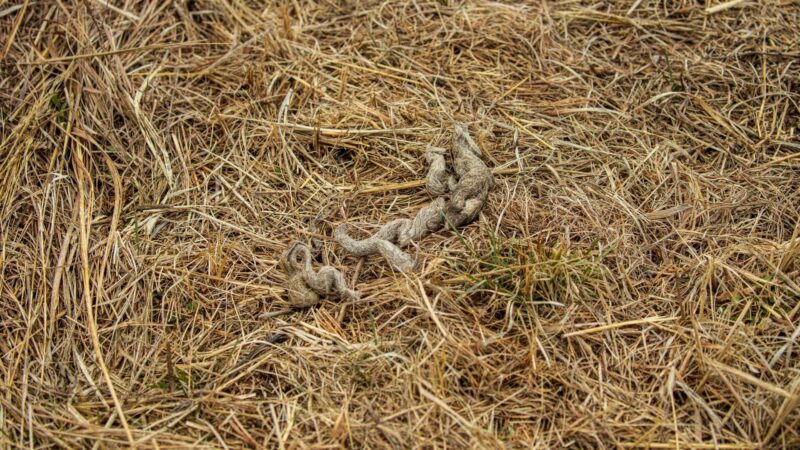
Apart from small bones and hair in coyote poop, here are the other characteristics:
- The coyote poop is typically an inch thick and four-inch long.
- The rope-like scat is oval, and it’s not soft as there are hair, seeds, and small bones.
- The poop colors vary based on climate. It’s bright in summer and dark in winter. It turns gray when it’s been lying on the ground for some time.
- The poop crumbles when a coyote eats fruits, while it’s black and semi-liquid when it has a meal of pure meat.
How to Identify a Coyote Poop?
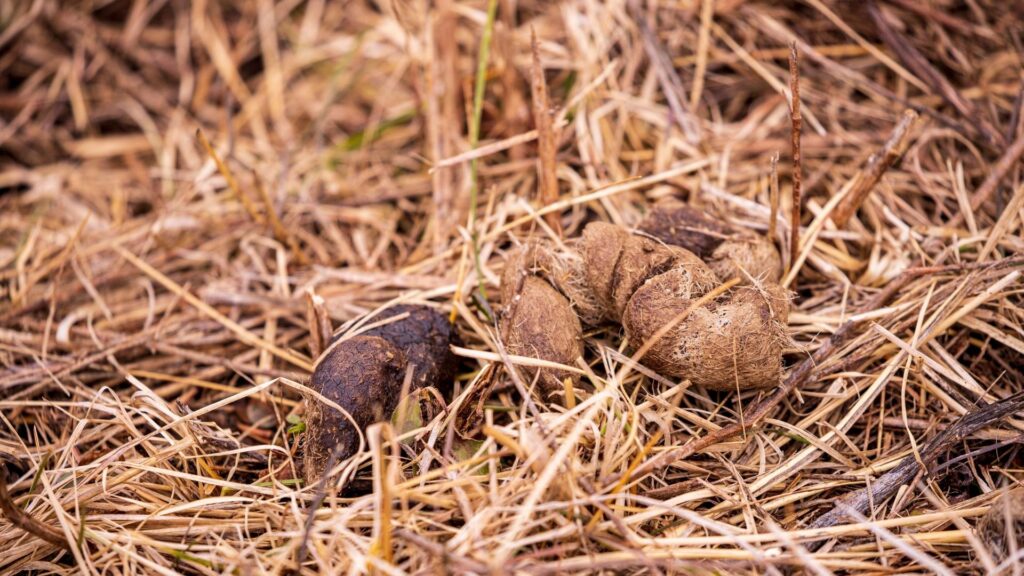
Besides the appearance, you can identify coyote poop by other means. There’s urine and feet or scratch marks around it.
With the foot marks, you have to know how the coyote’s four toes with the front ones that are more prominent appearance on the ground. The claws are curved with triangle-shaped palm pads.
There are times that the hind feet don’t completely leave a mark. Thus, you will see the smaller oval shape in the center. The front track is usually a length of 2.5 to 3.5 inches and a width of 1.7 to 2.8 inches.
Furthermore, the hind track can have a length of 2.4 to 3.3 inches and a width of 1.7 to 2.6 inches. Urine can also be found around the coyote poop.
The waste matter of a certain coyote is typically contained in one place as this animal uses its urine to mark its territory.
The Pooping Behavior of a Coyote
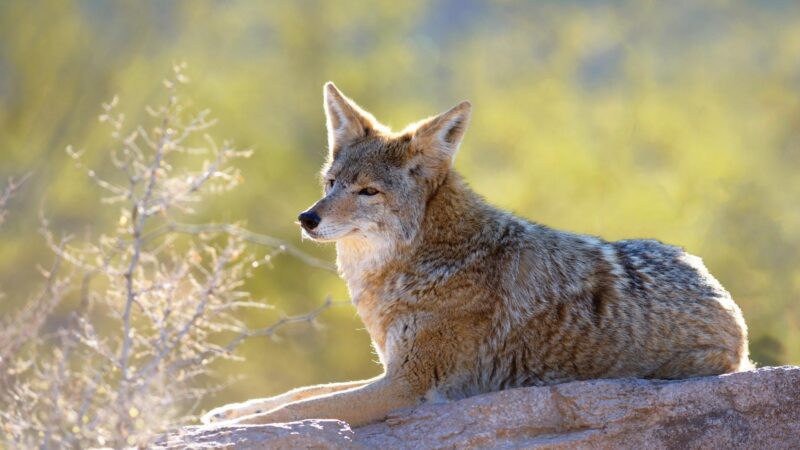
The coyote’s poop has various shapes, sizes, and compositions. It’s usually seen next to trails or other conspicuous areas, den sites, bedding, and the usual traveling route.
Is Coyote Poop Dangerous?
Coyote poop is dangerous as it’s filled with intestinal nematodes and filarial nematodes. These things were discovered by a study on coyotes in Georgia from Georgia Southern University. To be exact, coyote poop may have tapeworms and roundworms that cause diseases.
Removing Coyote Feces | Step by Step Guide
Since coyote feces can bring harm to humans, you have to know how to handle them. You have to remove them right away. Before getting into the step-by-step guide, don’t be reckless and do it with bare hands.
You don’t want to expose yourself to bacteria and viruses. Also, don’t sniff or put your face near the feces.
You have to prepare a shovel, respirator, gloves, and bags to get rid of coyote poop. Once you have the necessary materials, follow these steps:
- Put on the gloves and respirator. If necessary, wear boots and wrap them with some covering.
- If the coyote poop is dry, sprinkle warm water.
- Use the shovel to take the poop from the ground. Torch the poop to eradicate tapeworm and bacteria.
- Don’t just forget about the area where the poop was found. You need to disinfect it as well by pouring hot water and disinfectant on it.
- Take off the gloves and clean your hands with hot water that you can handle and soap. You’ll also need to wash your clothes after getting rid of the feces. Don’t mix them with other things.
How to Keep Coyotes Away?
Habituated coyotes become bolder if nothing deters them, so here are the ways to keep them away:
Fencing
Erecting a fence can stop coyotes from getting into your yard or property. You can have barbed wire, net wire, or electrical wires. But the combination of net wire and electric wire is the most effective when warding off coyotes. Electric wires need chronic maintenance, though.
Repellents
Human presence and strange sounds can keep coyotes away. You can utilize sonic visual devices like distress calls, sirens, No products found., radios, scarecrows, and lights. Unfortunately, you should choose some of these things and make them a combo to ensure efficacy.
- Larger, single reed flex tube design
- Coyote barks, howls and pup distress
- Plus, screaming cottontail distress
- Sports and Outdoors product
A setting becomes ineffective against coyotes through time. Thus, you have to work on another system so you can scare them in another way. You can also opt for chemical repellents like collars with odorous chemicals or odor stations and livestock body spray.
Guard Animals
Guard animals can be dogs, ostriches, emus, llamas, mules, and donkeys. But some studies find favor in dogs, specifically the breeds of Akbash, Anatolian Shepherds, Great Pyrenees, mongrels, and Komondor.
These canids should grow near the livestock, so they can be effective guard animals.
Diet of a Coyote
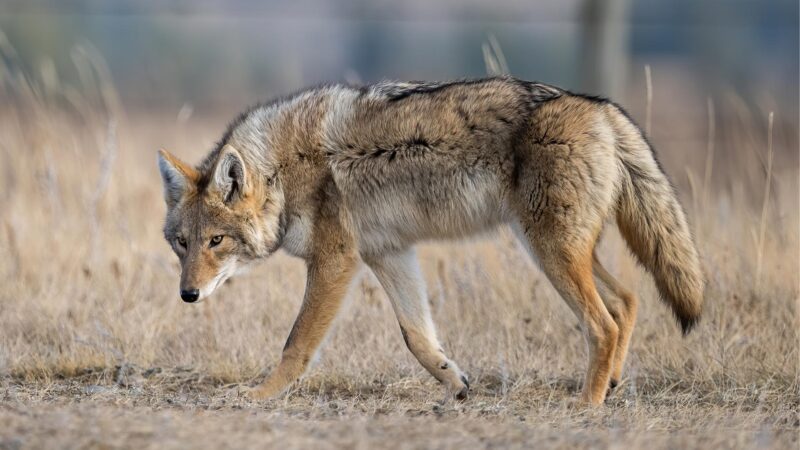
Coyotes are omnivorous, so they can get all the nutrition that they need. In winter and spring, coyotes live by mammals such as rats, mice, rabbits, squirrels, and voles.
In fall and summer, they consume berries, fruits, and vegetables due to the abundant supply.
What Does It Mean When a Coyote Poops in Your Yard?
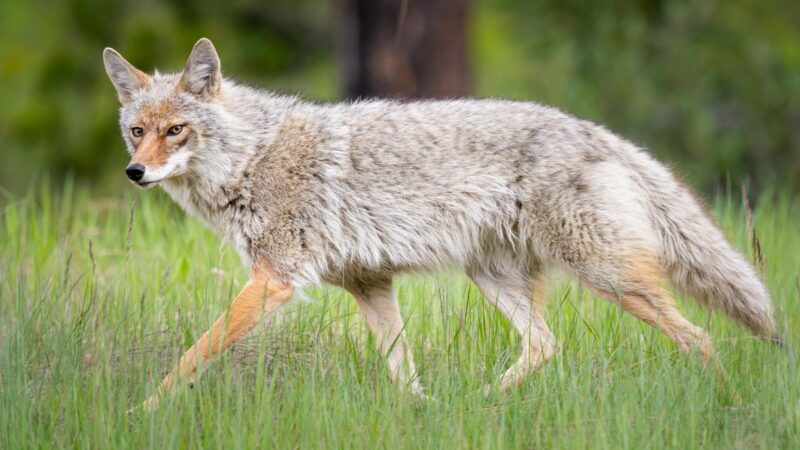
Seeing coyote poops in your yard means this animal is around as it can jump or climb fences and even crawl below net wire fencing.
How Do You Stop Coyotes From Pooping in Your Yard?
To stop coyotes from pooping in your yard, you can use the things mentioned above for keeping them away, such as fencing and repellents. Remove food sources outside your house like pet food, bird feed, trash, fruit, and veggie garden.
Since coyotes need a hiding place during the day, you have to clear possible hiding spots. They like hiding in wood piles and overgrown bush.
So, put the effort into trimming grass, bushes, and trees. You may need to trap rodents and get rid of their presence in your yard as coyotes prey on them.
Do Coyotes Defecate in the Same Place?
Coyotes defecate in the same place because they mark their territories. Once a coyote chooses your yard, it will keep on coming back to its favorite spot.
What to Do if Coyotes Are Near Your House?
When coyotes are near your house, here are the things that you have to do:
- Don’t allow the food sources to be accessible to them.
- Don’t approach and feed them.
- Never do something that can encourage getting near you.
- Don’t run away when you see coyotes. Face them and raise your hand and voice at the same time. You have to make them fear you. Throw rocks or sticks at them until they run away.
How Can You Tell Dog Poop From Coyote Poop?
You can tell dog poop from coyote poop through shape and claw marks. Dog poop is generally similar in length and width, while coyote poop has a longer length than its width.
The dog poop is usually accompanied by four claw marks. You’ll only see two front claws around coyote poop.
Is It True That Coyote Poop Can Kill You?
Coyote poop can kill you if it infects water and plants that weren’t washed thoroughly. The tapeworm from coyote feces can hatch oncospheres once it enters your body. They travel through your intestine and reach your brain, liver, and lungs.
These oncospheres can cause hydatid cyst, which develops for several years or decade. The removal of this cyst, called cystic echinococcosis, is possible, but it can be fatal due to a severe anaphylactic reaction when the cyst blows out.
Summary
Coyote poop can be in different colors since it’s an omnivore that consumes both meat and plants. Some hair and small bones can be found in it. There’s like a tail on both sides of the poop.
Seeing coyote feces means they’re around. Apart from knowing that they’re nearby, you should also know that this waste can carry bacteria and worms that cause diseases to humans.
List of Sources
Rollins, D. Coping with Coyotes. Texas A&M AgriLife Extension Service.
Dunn, A. C., Smith, M. D. (2011). The Coyote: Facts and Myths About Living With This Wild Canid. Alabama Cooperative Extension System.
Keegan, B. (2021). Autumn Coyote Sightings. Arnold Arboretum of Harvard University.
Banks, A. (2019). Investigating the Role of Coyotes, Canis Latrans, in the Spread of Parasites and Arthropod-Borne Diseases in Georgia, USA. Georgia Southern University.
